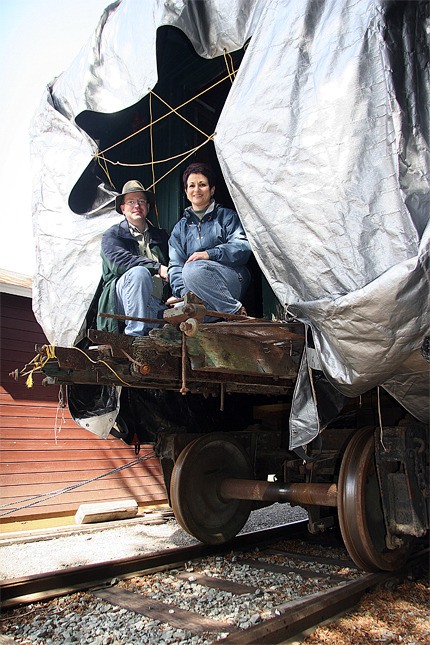The most important car in the Northwest Railway Museum’s collection is tucked out of sight under a silver tarpaulin.
The Messenger of Peace doesn’t get the celebrity status of Thomas the Tank Engine or as many looks as the curious old locomotives and rusty haulers parked along Snoqualmie’s Highway 202.
But the 112-year old chapel car, a church on wheels built by the American Baptist Publication Society to bring religion to Western communities without a house of worship, may get national attention through an online vote.
Through Wednesday, May 12, the chapel car restoration project is competing with two dozen other historic properties nationwide in the fifth annual Partners in Preservation grant program, funded by the American Express Foundation. The 10 top vote-getters will share $1 million.
If enough votes come in, the Partners in Preservation Award will help the museum finish a five-year restoration process, taking Messenger of Peace out from under wraps and in the spotlight.
Under that tarp, Messenger of Peace’s crumbling timbers, musty interior and mismatched wheels are a far cry from its gilded days of glory.
“To the casual observer, it probably looks like it’s in really poor condition,” said Richard Anderson, the museum’s executive director. “To my eyes, I am astounded at how complete it is.”
That doesn’t mean that rebuilding the Messenger of Peace will be a cakewalk. There are years of work ahead.
Luckily, the museum has amassed a wealth of historic detail on the chapel car, its missions, impact and materials.
“There is very little in the big picture that we don’t know about this car,” Anderson said.
Falling down
When Messenger arrived at the museum grounds three years ago, it was ready to fall to pieces. The car had been involved in a barge accident in the 1940s that severely damaged the frame, and had never been the same since.
“When they put a railroad car on deck, they chain it to the deck,” Anderson said. Workers who removed it from the barge either coupled it to hard or pulled it without removing the chains, severing an important steel frame component.
“Because of the redundancy of the frame, it hadn’t collapsed at that point,” Anderson said. But the years took its toll, and the frame needed emergency repairs when it arrived in Snoqualmie.
After retirement from religious runs in 1948, Messenger spent the next few decades as a roadside diner and private cottage, slowly deteriorating. Decades of rain on the Pacific coast rotted away the rear platform. Now, all that is left of the exterior deck is stubs of wood and rusty metal. But historic archives can put it all back together, including the recasting of an automatic coupler that hasn’t been made in a century.
It will cost about $450,000 to renovate Messenger of Peace. The museum has already secured $250,000 for the job from private and government sources, including a large award from the Save America’s Treasures program. Those funds have helped perform some of the most important work on the car, fixing the damaged frame that threatened to collapse the car. When final repairs are finished two years from now, the car will become a major museum exhibit.
On the road
Messenger of Peace brought religion to 11 states, but spent most of its operational life in Washington. It founded churches throughout the Northwest, including the forerunner to today’s North Bend Community Church.
All the railroad cars now found at the Northwest Railway Museum performed a job — fixing track, hauling lumber, goods or people.
“This car brought ideas to the community,” Anderson said. “Those ideas were far-reaching and long-lasting.”
Many of the cars in the museum collection have nationally-recognized regional significance, but the Messenger of Peace is the only one with recognized national impacts — one of 350 properties in the state recognized as such, but the only one in Snoqualmie.
“It rolled through this community, but it’s a national treasure,” Anderson said.
The Messenger is the first rail car to compete for funds in the five-year-old Partners in Preservation program.
“This is a watershed moment,” Anderson said. “This project is so unique, it’s difficult to compare to anything else we do here.”
Through the award program, the Messenger has a chance to grow interest in history, locally and beyond.
“By getting people excited about what we are doing — even if it doesn’t bring in additional funding — it gets the community to understand that place matters,” Anderson said. “We have a lot of history in this country, and it all needs preserving.”
Vote for the Messenger
Votes for the Messenger of Peace to win a Partners in Preservation grant can be made online through Wednesday, May 12. Voting started at 11 a.m. Thursday, April 15.
Residents can vote once a day during the four week voting period.
The Northwest Railway Museum will host an open house featuring the chapel car, Saturday and Sunday, May 1 and 2.
To vote, visit www.preservatinnation.org/partners-in-preservation/seattle/.
To learn about the chapel car, visit www.messengerofpeace.org.



